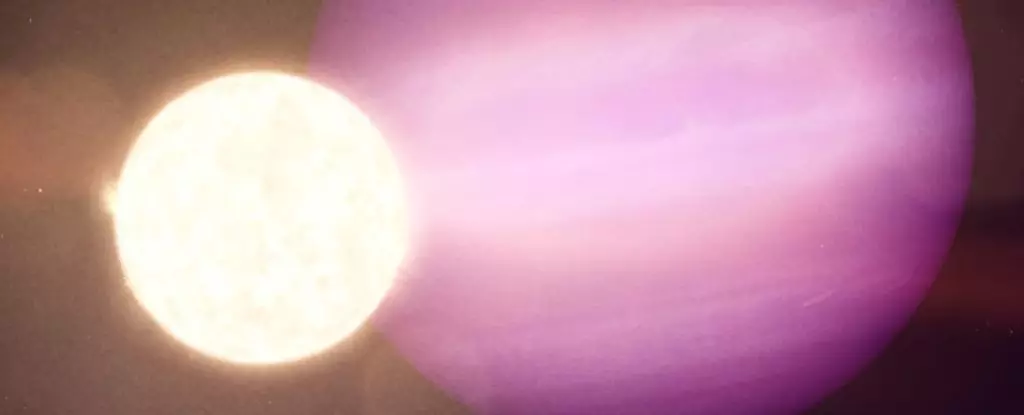In the vastness of our universe, technological advancements in astronomy have allowed us to glimpse the remarkable diversity of planetary systems beyond our solar neighborhood. Among these exciting findings is the discovery of WD 1856+534 b, a gas giant that has captivated scientists since its detection in 2020. Orbiting a white dwarf star located 81 light-years away, this exoplanet garners attention not only for its sheer mass—about six times that of Jupiter—but also for its cold temperatures, making it the chillest exoplanet ever recorded.
The study of WD 1856+534 b has opened a Pandora’s box of intriguing possibilities regarding the nature of planetary survival in hostile environments. As a “super-Jupiter,” WD 1856+534 b is unique, embodying an opportunity to study the dynamics between dying stars and their remaining planetary companions. The international collaboration among astronomers, led by Mary Anne Limbach from the University of Michigan, underscores the importance of interdisciplinary approaches in unraveling cosmic phenomena.
Cutting-Edge Technology: The Role of James Webb Space Telescope
A significant advantage in exploring the depths of this exoplanet was made possible by the James Webb Space Telescope (JWST). Equipped with state-of-the-art instruments like the Mid-Infrared Instrument (MIRI), JWST allows scientists to conduct direct observations in ways previously thought impossible. By employing the Direct Imaging Method, researchers analyze light reflected off WD 1856+534 b’s atmosphere to discern atmospheric components. The critical measurements achieved through JWST not only corroborated existing observations but also provided fresh insights.
Through this advanced technology, researchers detected that WD 1856+534 b has an average atmospheric temperature of approximately 186 K (-87 °C; -125 °F). This groundbreaking finding positions the planet at a borderline condition where characteristics similar to Earth may emerge, raising questions about the potential for habitability even in less-than-ideal environments.
Challenges and Triumphs in Exoplanet Observation
Nonetheless, exploring the realm of exoplanets remains fraught with challenges. Detecting light directly from planets—the so-called “light pollution” caused by the brilliant glare of host stars—complicates the observation process. Traditionally, scientists have focused on larger, hotter gas giants with expansive orbits, as smaller, cooler planets get lost in the luminous backdrop.
WD stars like WD 1856+534, however, represent a unique class of celestial bodies that could change the game of exoplanet exploration. As remnants of stars that once resembled our Sun, white dwarfs offer a lesser degree of luminosity, allowing for clearer observations of orbiting planets. For instance, the reduced light intensity from WD 1856 allows astronomers to confirm the existence of colder planets, lending credibility to theories about planetary development in varying stages of stellar life.
The Broader Implications for Planetary Science
The investigation into WD 1856+534 b yields substantial implications for understanding planetary systems’ post-main-sequence evolution. This study poses consequential questions: Can planets endure the tumultuous phases of a star’s lifecycle? Is it feasible for habitable conditions to persist around white dwarfs? Studying such exoplanets helps astronomers piece together the bigger puzzle of how planetary systems adapt over cosmic timescales.
Moreover, Limbach and her team’s recent findings resolve some long-standing uncertainties regarding the mass of WD 1856+534 b, clarifying it to range no greater than six times the mass of Jupiter—a significant reduction from earlier estimates that posited a value as high as 13.8 Jupiter masses. This recalibration of the exoplanet’s mass can assist in refining models of planetary formation, migration, and atmospheric composition in various astrophysical contexts.
A Promise of Future Discoveries
Excitingly, this is just the beginning. Continuing observations of WD 1856+534 b scheduled for 2025 promise to delve deeper into this fascinating cosmic entity. Researchers expect these upcoming studies to potentially unveil additional planets within the same Pleiades system and explore the degree to which WD 1856 b may have undergone migration into its current orbit.
The future of interstellar exploration shimmers brightly with the advancements our technology has provided. As we harness the capabilities of groundbreaking observatories like JWST, we inch closer to uncovering the fundamental questions surrounding life’s existence beyond Earth. With every finding, we strip away layers of cosmic ignorance, inch by inch revealing the rich diversity that our universe holds. Each discovery—like that of WD 1856+534 b—underscores the notion that we are mere novices in the grand theater of astronomical exploration, a narrative that is yet to unfold in its entirety.


Leave a Reply